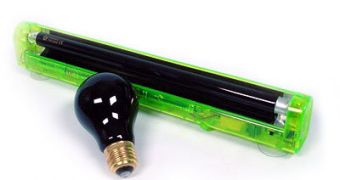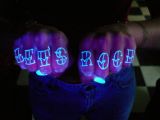Black lights may occasionally be disguised into traditional lighting sources such as incandescent light bulbs or fluorescent tubes, but they function and have different roles than those of ordinary lighting sources. Black lights are mostly used in order to make certain substances or objects 'glow in the dark', such as teeth or white clothes.
Basically, what we call 'black light' represents light emissions in the ultraviolet wavelengths of the electromagnetic spectrum. While visible light has wavelengths between 380 to 750 nanometers, ultraviolet light is shifted towards the ultraviolet end of the visible spectrum and may span between 400 to 10 nanometers, meaning that the human eye is only able to view within a small portion of the ultraviolet spectrum.
Black light fluorescent tubes and light bulbs
Most black light sources peak at 365 nanometers and use phosphor to convert energy into ultraviolet radiation. Usually black light sources can be found in the form of fluorescent tubes. Ordinary fluorescent tubes work by discharging an electrical current between two metal filaments inside an inert gas, usually containing small amounts of mercury vapor. The mercury atoms convert part of the energy into light, most of which is in the ultraviolet spectrum.
However, ultraviolet light is invisible to the human eye, thus phosphor coatings are used to convert it into visible light. Black light on the other hand works by a slightly altered principle. Special phosphor coatings are used in order to filter out the ultraviolet-B and ultraviolet-C wavelengths while emitting only ultraviolet-A light, non-harmful for the human eye.
Incandescent black light bulbs are basically constructed in the same manner as ordinary visible light bulbs, albeit the external surface of the glass bulb is coated with phosphor which absorbs visible light, and emits infrared and ultraviolet wavelengths.
Applications
Black lights are mostly used for entertainment, to make certain substances and objects glow in the dark. Alternatively, black light may be used to find leaks in machinery, as counterfeit protection in money and identification papers or in forensic investigations. Most if not all applications usually have the same operation method and role - to make substances invisible in normal circumstances appear visible.

 14 DAY TRIAL //
14 DAY TRIAL // 
